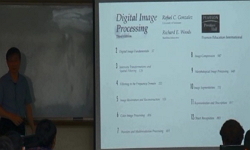Hay quality is an important factor that affects yield and quality of animal products. It also influences its market price. Therefore, it is crucial to have quantitative value on hay quality. Conventionally hay quality is judged manually by its appeara...
http://chineseinput.net/에서 pinyin(병음)방식으로 중국어를 변환할 수 있습니다.
변환된 중국어를 복사하여 사용하시면 됩니다.
- 中文 을 입력하시려면 zhongwen을 입력하시고 space를누르시면됩니다.
- 北京 을 입력하시려면 beijing을 입력하시고 space를 누르시면 됩니다.
Application of Near Infrared Spectroscopy, Digital Image, and Smell Sensor to Classify Quality for Taiwanese Pangola Hay = Application of Near Infrared Spectroscopy, Digital Image, and Smell Sensor to Classify Quality for Taiwanese Pangola Hay
한글로보기https://www.riss.kr/link?id=A105775200
- 저자
- 발행기관
- 학술지명
- 권호사항
-
발행연도
2018
-
작성언어
-
- 주제어
-
KDC
500
-
자료형태
학술저널
-
수록면
82-82(1쪽)
- 제공처
-
0
상세조회 -
0
다운로드
부가정보
다국어 초록 (Multilingual Abstract)
Hay quality is an important factor that affects yield and quality of animal products. It also influences its market price. Therefore, it is crucial to have quantitative value on hay quality. Conventionally hay quality is judged manually by its appearance, smell, and chemical composition that needs tedious laboratory analysis. Spectroscopy in near infrared, digital image technique, and electronic smell senor are techniques that have been broadly studied in agricultural field. They contain many advantages, such as, simple preparation for samples, non-destructive on samples, and quick detection. This study applied these three techniques in hay quality evaluation. Seventy Pangola hay samples were randomly collected from Kenting, a southern town in Taiwan. Each sample was scanned by a monochrometer (microPHAZER) to record its reflective spectrum at 1600~2400 nm. Its digital color image was taken by a commercial camera in a small chamber after a calibration process was performed. And the response curve of electric resistance change detected by three SiO<sub>2</sub> gas sensors of MQ5, TGS800, and TGS 822 were recorded for 15 minutes. These records were used to calibrate a prediction/classification model for hay quality evaluation. Among these sample data, 2/3 of them were used as calibration set while the rest were used as test set. For spectroscopy to predict composition, PLSR (Partial least square regression) and MLR (Multiple linear regression) models were tested to predict CP (Crude protein), NDF (Neutral detergent fiber) and ADF (Acid detergent fiber). Results showed the best model was found at PLSR that had correlation coefficient (R) on prediction and measurement on test set of 0.89, 0.80, and 0.71 for CP, NDF and ADF respectively and with RMSEP (root mean squared error of prediction) value of 1.04, 1.34, and 2.30. For digital image, expert score on each sample was calibrated with LDA (linear discriminant analysis) model and 79 features extracted from image were used. Results indicated that two groups classification accuracy was 100% in color for test set. For smell detection, four features were extracted from the response curve and LDA for two groups was tested. The classification accuracy was about 87% in test set. The study developed a GUI (Graphic user interface) to integrate these three quality evaluations for field application. In terms of contribution, this study developed a hay quality evaluation system that offers quick and nondestructive method. The system is portable and can be carried and operated in field.
동일학술지(권/호) 다른 논문
-
Development of an Indoor Positioning System for Greenhouse Flying Robot
- 한국농업기계학회
- ( Ming-jhe He )
- 2018
-
An Imaging System for Monitoring the Feeding Behavior of Dairy Cows
- 한국농업기계학회
- ( Cheng-yu Kuan )
- 2018
-
Study on Water Uptake of Coffee Bean using Magnetic Resonance Imaging
- 한국농업기계학회
- ( Seung Hoon Baek )
- 2018
-
Development of Sensing Device for Plant Conditions Utilizing Lazer Speckle Method
- 한국농업기계학회
- ( Takashi Fukushima )
- 2018




 KISS
KISS






